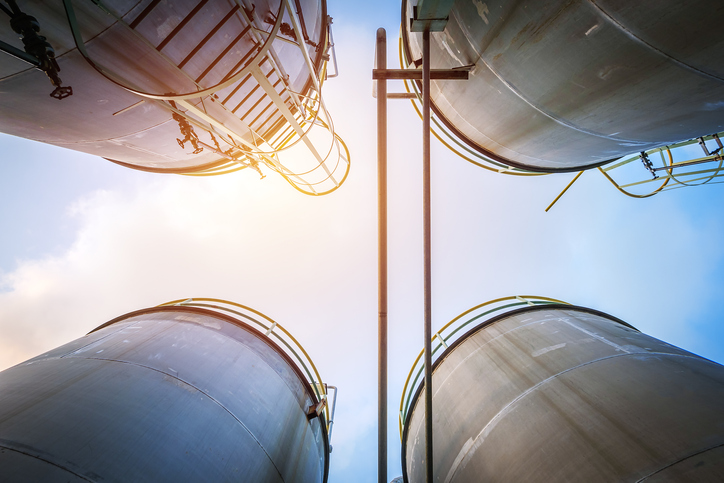Tired of Those Annoying 55-Gallon Drums and Totes? Go with Chemical Holding Tanks Instead
You’re not alone. For years, companies that manufacture products using polyurethane or that apply polyurethane in other applications have been ordering, hauling, storing, and handling material in 55-gallon drums rather than chemical holding tanks. For companies with more significant production demands, this inefficiency was upsized into significantly larger 270-gallon totes. Depending on overall production volume, companies might have anywhere from dozens to hundreds or even thousands of these drums in their facilities throughout their footprint.
To solve this challenge, companies such as Linden Polyurethane offer bulk chemical holding tanks as a replacement for cumbersome drums and totes. These large material containers are designed to hold a wide variety of chemicals such as the core components of polyurethane (polyol and isocyanate), environmentally friendly Cyclo-Pentane, or hydrofluoro-olefin (HFO). Chemical holding tanks come in a variety of sizes ranging from 2,000-gallon tanks that can be refilled by tank trucks to 20,000-gallon tanks that can be supplied via rail car deliveries.
While there are numerous productivity and efficiency benefits of chemical holding tanks, there are naturally a number of financial benefits as well. Here, we’ll explore how chemical holding tanks can make a long-term financial impact on your organization.
Why Chemical Holding Tanks Are Worth the Investment
1. They Make Ordering More Cost-Effective
Previously, companies in need of material had orders fulfilled in barrels, drums, and totes — each of which translates into higher customer costs. For example, 55-gallon drums can cost anywhere from $100 for basic or refurbished options to nearly $1,000 for more advanced versions. Suppliers likely passed some of those costs along to their customers. That, and it’s simply more expensive to manage the filling and distributing drums and totes. Each has to be cleaned, filled, sealed, handled, and shipped — all of which requires time and labor.
And that’s all just on the supplier side! Once a drum arrives at your facility, your team has to manage moving the barrel to where it’s needed, emptying it or connecting it to a system, and so on. The expenses simply add up with drums and totes. But with a chemical holding tank, companies no longer have to deal with the inefficiencies these smaller containers pose. A single order can be placed for a large volume of material, which is then delivered by a truck or even a rail car for larger facilities.
2. They Enhance Production Workflows
The last thing you and your team need when you’re navigating a heavy production cycle is to get bogged down with countless drums and totes. These can clog up your facilities’ storage areas and production floor. They also bog down your team who have to handle moving them from place to place, getting more when one drum is empty, and so on. They’re simply a nuisance that prevents you from achieving greater levels of efficiency and productivity.
Chemical holding tanks provide strategic value here in that they can become the pillar of your production environment. Depending on the volume of material needed, tanks can be positioned right in your production environment to ensure that whatever material you need is quickly and easily accessible. They can also be strategically positioned for faster and easier resupply. Organizations with larger production needs can have their tanks built near receiving areas for truck-based resupply or near rails for railcar deliveries. These efficiencies reduce the amount of time your team has to spend on resupply, handling, and so on.
3. They Can Be Deeply Integrated
The key to a successful production environment is creating harmony and efficiency between cycles and stages. For example, if you’re spraying sporting goods products with a certain chemical mixture, there are a number of systems in play moving material from a chemical holding tank through an appropriate metering system into the mix head and finally onto the product itself. Each of these systems employs advanced functions and their own precise engineering to make their respective parts successful.
Chemical holding tanks are the source of that success. None of your machines and processes can do what they do best without material. Whether your production calls for a stream of material for open pouring and spraying or a consistent yet segmented distribution process for closed pouring at smaller volumes, having all of the material you need when you need it will keep production moving smoothly. This results in more polyurethane applications completed in less time and with fewer interruptions and thus less expense.
4. They Can Be Customized for Your Unique Needs
Not every production environment is the same. Your products, production schedule, budget, and other factors all determine the type of equipment and solutions you need. Why complicate matters with more burdensome barrels, drums, and totes? Chemical holding tanks can be built to your most custom specifications to ensure that the storage solution you get not only supports your workflow and schedule but also enhances it for the future.
Examples of features and functions that can be added to a standard chemical holding tank include unloading pumps/filters, material returns for QC fails, heating and cooling, tank agitation, insulation, material level sensing, and safety/accessibility features like catwalks for multiple tank installations. Whatever your production needs may be, there’s likely a feature or capability that can be added to your chemical holding tank to make it work better for you.
Ready to Learn More About Custom Chemical Holding Tanks?
Your polyurethane material is the foundation of your organization and production environment. Don’t allow managing it to become a hassle. With a chemical holding tank from Linden Polyurethane, you can buy material in bulk and deeply integrate the tank into your workflow. As the only U.S.-based manufacturer of custom-engineered polyurethane solutions, we can work with you to design the ideal chemical holding tank for your production needs.
Contact us today to discuss your production goals and material handling needs.





